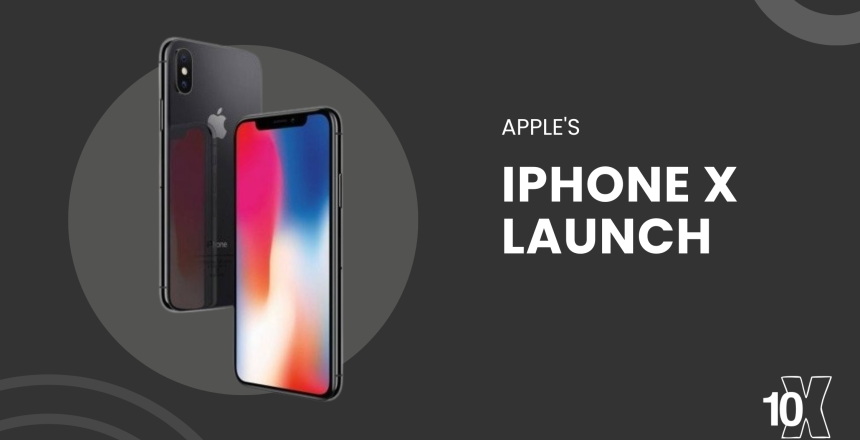Apple’s iPhone X was a smartphone launched by the company in 2017. The device was designed to be the flagship model in Apple’s smartphone lineup and featured a number of unique and innovative features.
One of the key elements of the iPhone X launch was its focus on delivering a high-quality and immersive user experience. The device featured a number of cutting-edge technologies, such as an edge-to-edge Super Retina OLED display, Face ID facial recognition technology, and augmented reality capabilities, which helped to provide users with an incredibly rich and engaging user experience. These features helped to differentiate the iPhone X from other smartphones on the market and contributed to its appeal among consumers.
In addition to its focus on user experience, the iPhone X launch also included a number of other elements that helped to generate excitement and buzz for the device. For example, Apple partnered with several retailers and carriers to offer special promotions and discounts for the iPhone X, which helped drive the adoption and usage of the device. Apple also used its social media channels and other marketing channels to promote the iPhone X launch, which helped generate additional buzz and engagement.
Overall, the iPhone X launch was a success for Apple. The device’s focus on user experience and its partnerships and promotions helped generate a significant amount of buzz and excitement and contributed to strong sales for the company. The iPhone X’s success helped reinforce Apple’s position as a leader in the smartphone industry.
Reasons for the success of Apple’s iPhone X launch
Several reasons may have contributed to the success of Apple’s iPhone X launch:
- Strong brand reputation: Apple has a strong brand reputation and loyal customer base, which likely contributed to the success of the iPhone X launch.
- High demand for new and innovative products: Apple has a history of introducing new and innovative products, and the iPhone X was no exception. Introducing new features, such as facial recognition and an edge-to-edge display, likely generated high demand for the product.
- Good timing: The iPhone X was released when there was a high demand for smartphones with advanced features.
- Strong marketing campaign: Apple’s marketing campaign for the iPhone X was highly effective, with the company using various marketing channels, such as social media, television commercials, and in-store promotions, to generate buzz and excitement around the product.
- High price point: The iPhone X was released at a higher price point than previous iPhone models, which may have contributed to its success as it appealed to consumers willing to pay a premium for a high-end smartphone.
Limitations to Apple’s iPhone X launch
Some possible limitations that the company may have faced include the following:
- Competition: Apple’s iPhone X launch occurred when there was significant competition in the smartphone market, with other companies releasing new models around the same time.
- Price: The iPhone X was significantly more expensive than previous models, which may have limited its appeal to some consumers.
- Production issues: There were reports of production delays and supply chain challenges leading up to the launch of the iPhone X, which could have affected the company’s ability to meet demand.
- Negative reviews: Some reviewers and consumers had negative experiences with the iPhone X, which could have negatively impacted its success.
- Market saturation: The smartphone market was relatively saturated at the time of the iPhone X launch, which could have limited the potential for growth.
Criticism against Apple’s iPhone X launch
One possible criticism of Apple’s iPhone X launch is the high price of the device, which may have deterred some potential customers from purchasing it. Another criticism may have been the limited availability of the device, as it was released in limited quantities and may have been difficult for some consumers to get their hands on. Additionally, some users may have been hesitant to purchase the iPhone X due to the lack of a home button and the introduction of new features, such as facial recognition, which may have been unfamiliar to some users. Finally, the iPhone X faced competition from other high-end smartphone options, which may have affected its success.
Marketing lessons from Apple’s iPhone X launch
The Apple iPhone X launch was a major success for the company, and several marketing lessons can be learned from this campaign. Some of these lessons include:
- Build anticipation: Apple is known for creating buzz and anticipation around its product launches, and the iPhone X was no exception. By teasing the release of the phone and releasing limited information about its features, Apple was able to build up hype and excitement leading up to the launch.
- Utilize social media: Apple used social media platforms like Twitter and Instagram to promote the iPhone X and engage with consumers. This helped to reach a wider audience and create a sense of community around the product.
- Partner with influencers: Apple partnered with influencers and celebrities to promote the iPhone X, which helped to increase its visibility and credibility.
- Create a sense of exclusivity: Apple released a limited number of iPhone X units at launch, which helped to create a sense of exclusivity around the product. This can be an effective way to drive demand and increase the perceived value of a product.
- Focus on the customer experience: Apple is known for its customer-centric approach, and the iPhone X launch was no exception. The company focused on providing customers with a seamless and enjoyable experience, from pre-ordering to product launches. This helped to build customer loyalty and drive repeat business.

